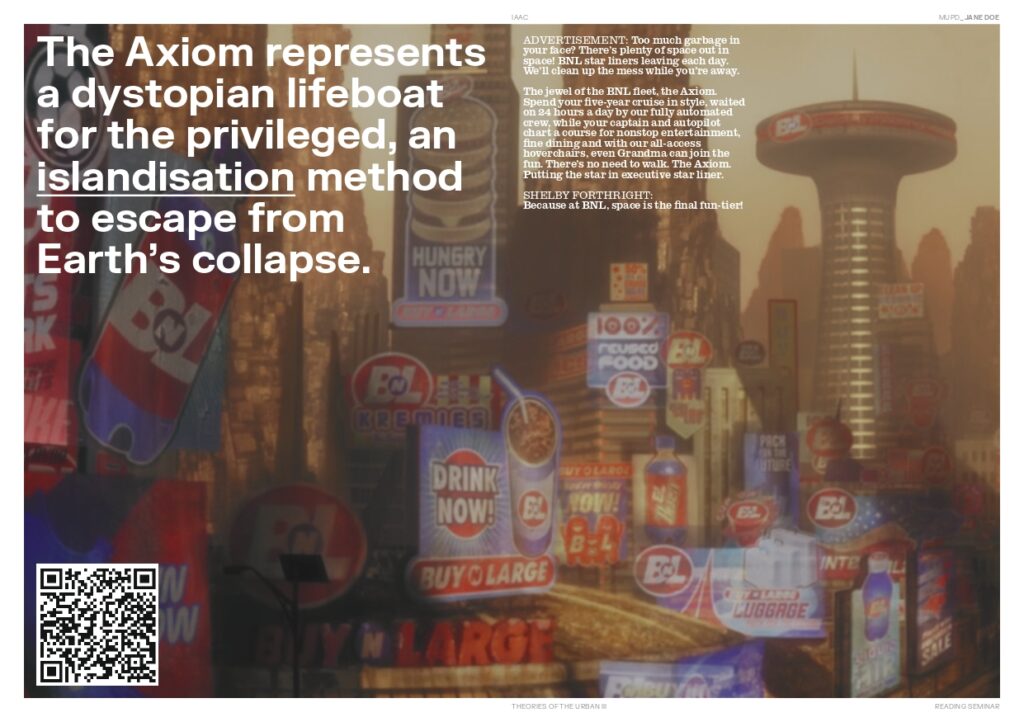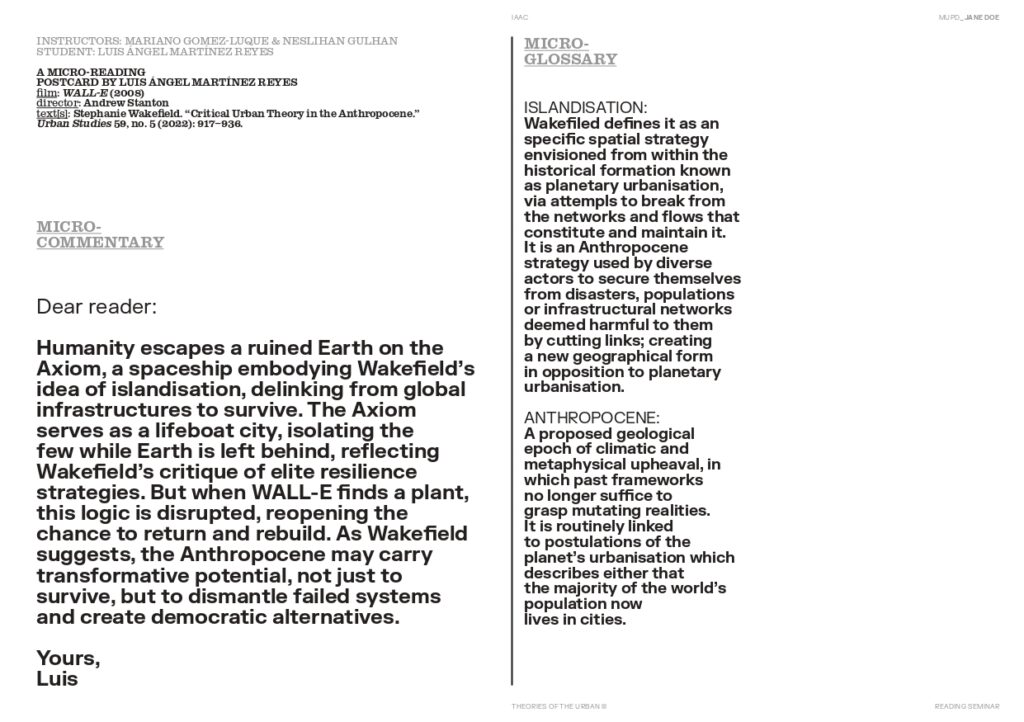In our final presentation for the Theories of the Urban course, we explored the film Leave the World Behind (2023) as a speculative lens through which to interrogate contemporary urban conditions. Though the narrative unfolds in a seemingly remote, rural setting, its core tension emerges from the collapse of deeply urban and planetary systems [technological, logistical, and communicational]. Drawing from key readings in class, including Kim Stanley Robinson’s reflections on Wilderness and Utopia, our group analyzed two pivotal scenes in the film. Each of us developed a micro-reading to unpack how these moments illuminate broader urban theories.
One of the first concepts we encountered in the course was hyper-reading. Inspired by this approach, we applied a similar strategy to the medium of film in what we call hyper-watching. Rather than passively consuming the narrative, we selected and closely analyzed two key scenes from the movie, treating them as dense texts full of urban theoretical significance.
Hyper-watching the film Leave the World Behind: https://drive.google.com/file/d/1BwSvVUlzQZ5h4Di6RT5Rkg_yOFb1ALye
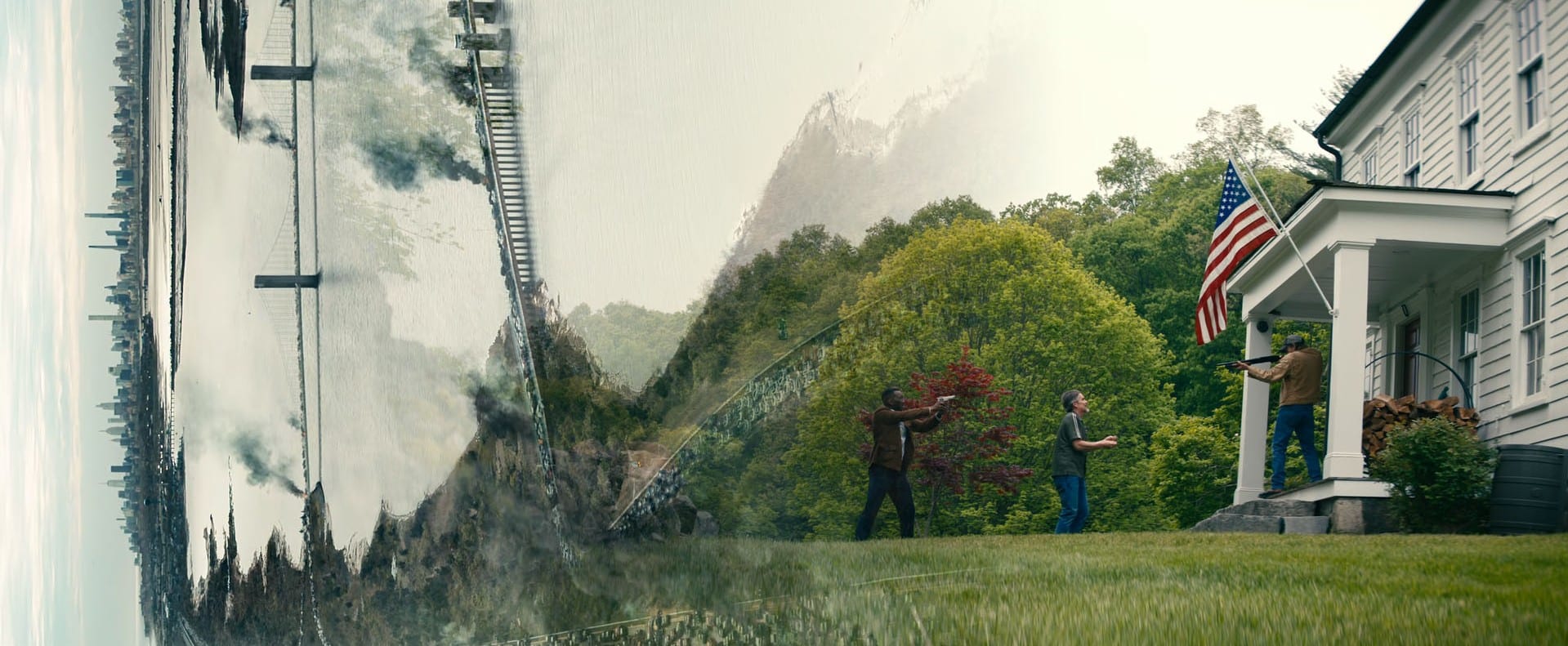
The first scene depicts self-driving Teslas crashing into one another on a congested highway, dramatizing the failure of technological systems designed for efficiency and control. The second shows Clay declaring himself a “useless man” after losing access to digital infrastructure, set in what appears to be a rural retreat outside the urban core. In both cases, the film challenges the boundaries between rural and urban, revealing how life in the so-called periphery remains deeply entangled in the networks of planetary urbanization.

01. Urbicidal Futures.
By Lakshmi Narayanan
The first part of the presentation is about situating the movie, it’s context within the readings and rest of the seminar. This selected scene happens in a blackout where two men try to take help from a former friend. If we look at the context, it is actually not a city or metropolis but it is happening in a remote/sub-urban. This explains that blackout affecting mostly the cities without internet, power and communication.
In today’s globalized world, the failure of a single infrastructural system—be it financial, logistical, ecological, or technological can trigger ripple effects that are felt across the entire planet. This interconnectedness reflects the insights of science fiction writer Kim Stanley Robinson, who highlights how contemporary infrastructural systems such as supply chains, data networks, and energy grids—interweave cities with rural areas, dissolving the traditional spatial and conceptual divisions between them. What once seemed like distinct domains are now part of a continuous flow of resources, information, and labor. Robinson’s work underscores how the myth of “wilderness,” long romanticized as a pristine realm separate from human activity, is in fact a cultural construction. The notion that nature exists independently, “where man is a visitor only,” no longer holds in an era where human impact is embedded in every ecosystem on Earth.
This perspective aligns with the theory of planetary urbanization developed by Neil Brenner and Christian Schmid. They argue that urbanization is no longer confined to the physical footprint of cities; rather, it has expanded to cover virtually the entire globe. In their view, the processes and structures of urbanization spanning agriculture, mining, transportation, and communication extend deep into what we have historically categorized as rural or natural spaces. As a result, the binary distinction between urban and rural has become obsolete. Instead, we now inhabit a planetary system in which all territories are implicated in the dynamics of urbanization, from remote hinterlands to dense metropolitan centers.


02. Urban and Technological Artifacts.
By Daniela Rodríguez Mattos
Instrumentality operates through urban and technological artifacts by q systems of control, efficiency, and optimization into the fabric of daily life, yet in doing so, it often renders these systems brittle, alienated from human context, and prone to failure when disconnection occurs.
Imagine you’re driving down a quiet road, trying to escape a vague emergency. But as you turn the corner, you find dozens of self-driving Teslas abandoned, silent, perfectly aligned, yet completely useless. This isn’t a scene from a distant future. It’s from Leave the World Behind. But it’s also a mirror of our present. This image captures more than just cinematic tension, it encapsulates a key concept in urban theory: the collapse of technological instrumentality. A world built for circulation now becomes a world of paralysis.
Cities today are no longer isolated islands. From highways to data farms, rural to remote everything is urbanized in function, if not in form. This is planetary urbanization, as described by theorists like Neil Brenner. Even Long Island in the film isn’t “outside” t’s just another node in a failing system.
Evgeny Morozov warns us: when we treat technology as neutral tools for optimization, we ignore the social, ethical, and political structures they reinforce. Self-driving cars, predictive infrastructures, AI all promise control and comfort. But what happens when they collapse? As in the film, we see not chaos but disconnection. No signals. No explanations. Just stranded autonomy. This is the moment when technological instrumentality reveals its limits, and exposes our dependence on a network we no longer understand.
This is not the dystopia of explosions. It’s the slow apocalypse of miscommunication, of systems failing silently, of human beings losing orientation. Dystopia today is a loop of the present, not a rupture. It’s a permanent now. No new birth, no future. The breakdown in Leave the World Behind isn’t spectacular, it’s intimate. The phones don’t work. The neighbors disappear. The city continues to exist, but the urban promise of connection collapses into isolation.
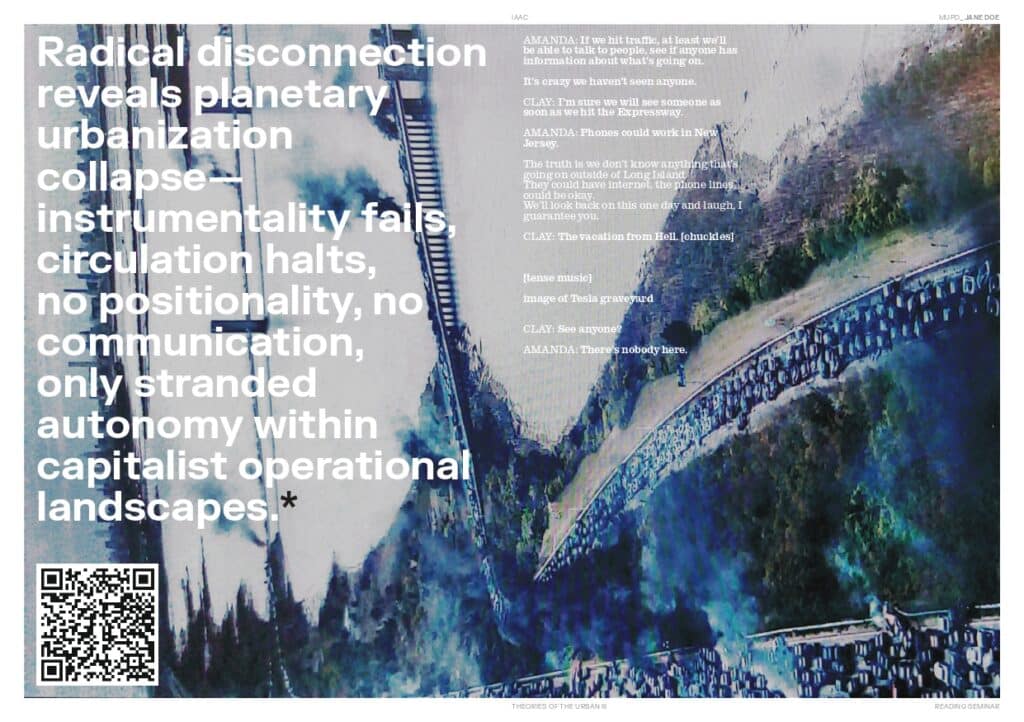

03. Islandization in the Planetary Grid.
By Luis Ángel Martínez Reyes
When Clay refers to himself as a “useless man,” he is not suggesting a lack of skills or capabilities. Rather, he expresses a profound disorientation tied to his embeddedness in a system that defines individual worth through participation in a broader network: The Planetary Grid. This grid encompasses digital, computational, logistical, financial, and social infrastructures sustained by the neoliberal capitalism.
The film explores the implications of this grid’s collapse, and with it, Clay’s own loss of identity and purpose. Yet, what ultimately endures beyond the technological breakdown are the underlying values ingrained by the capitalist system: competition over resources, distrust of others, even friends and neighbors, and a profound sense of isolation from the rest of the world.
This leads to what Wakefield calls Islandization: a mechanism of self defense tha tinvolves the creation of isolated zones of safety from the world chaos. In Wakefield’s case, the chaos is the climate change, however in the movie the chaos is the cyberattack and disconnection. We see three cases of islandization in the movie: the first one with Danny keeping his family and his resources inside of his house to protect them from the situation they are facing, the second are the bunkers built by wealthy people like the Thornes family to protect themselves from doomsday, and finally an involuntary islandization which is Clay and George’s families, whohave to create a “community” at George’s house, which is isolated from the rest of the world because of the characteristics of the urban fabric in this suburbs. But in the end, islandization only fragments the collective urban condition, it doesn’t save it. In a world shaped by planetary urbanization, disconnection is not an individual problem, it’s a systemic breakdown that reveals the fragility of the urban world we take for granted.
We live in a world that calls itself as hyperconnected, however situations like the April 28 blackout in the Iberian Peninsula demonstrate that we are not. Somehow we are starting to depend too much on the new technologies that are appearing in our lifes, even in built environment professions, but perhaps we should take a look back to how all of our cities origins happened without this technologies; perhaps as urban thinkers we should question ourselves on how to design in a more human way, where technologies and artifacts don’t serve capitalism but have a more human purpose (in this case the word human is used to encapsulate the best values of human like cooperation, respect and solidarity), so if one day the planetary grid falls, even the most remote point in the planetary urbanization won’t become a dystopia as portayed in the movie, but becomes a self-sufficient livable shared urban space.
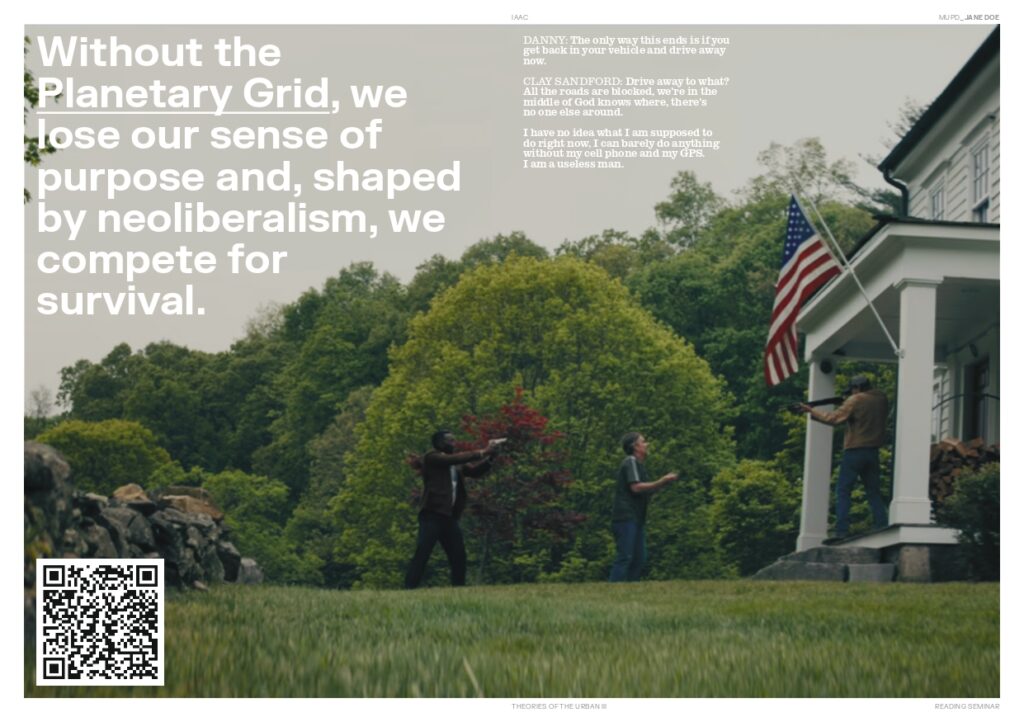

Extended reflections
In addition to our main analysis of Leave the World Behind, we also explored scenes from other films through the lens of urban theory. While they were not included in our final presentation, they reflect our ongoing engagement with the course readings and our effort to connect cinematic moments with critical urban concepts. Each postcard serves as a compact theoretical reflection, linking visual elements of the film to the readings and concepts explored throughout the course.
Lakshmi Narayanan
Minority Report (2002)
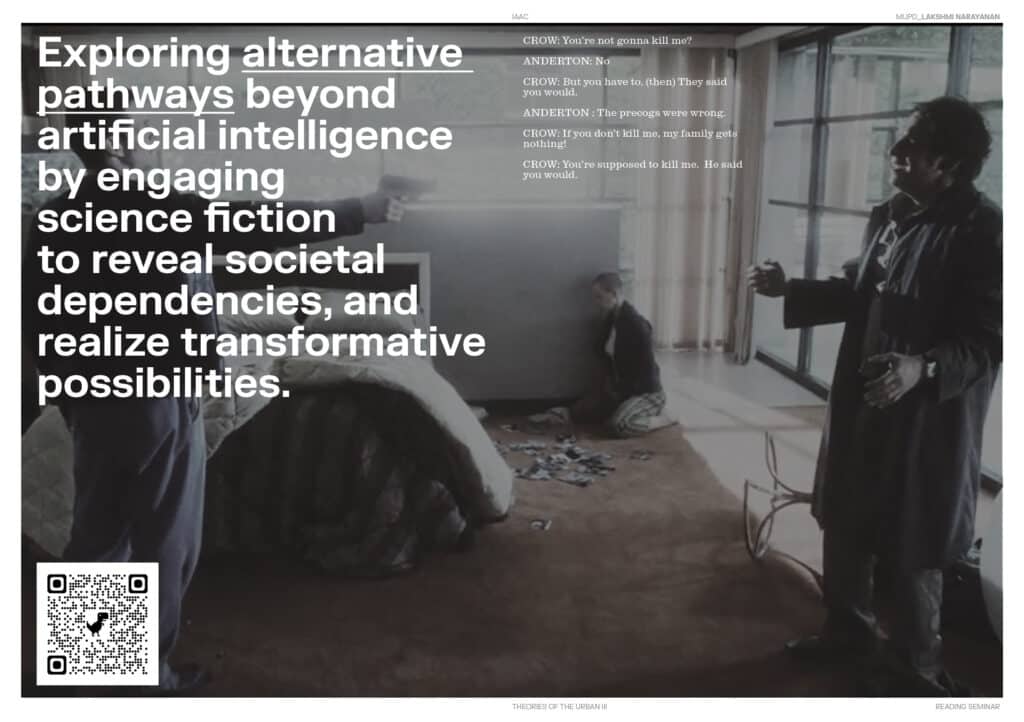
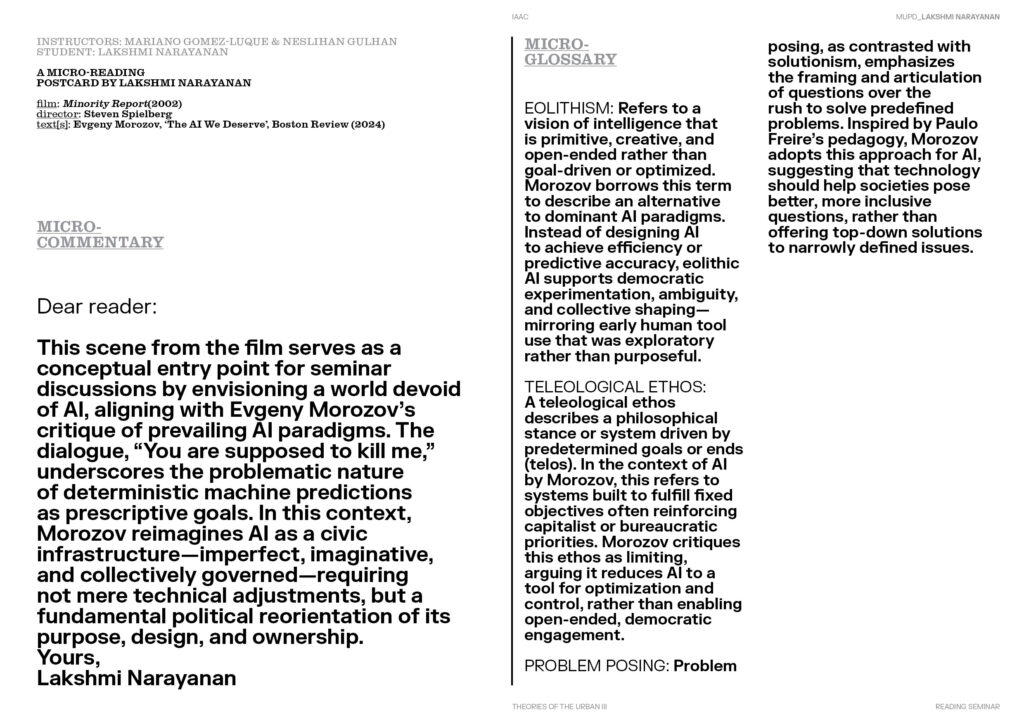
Children of Men (2006)
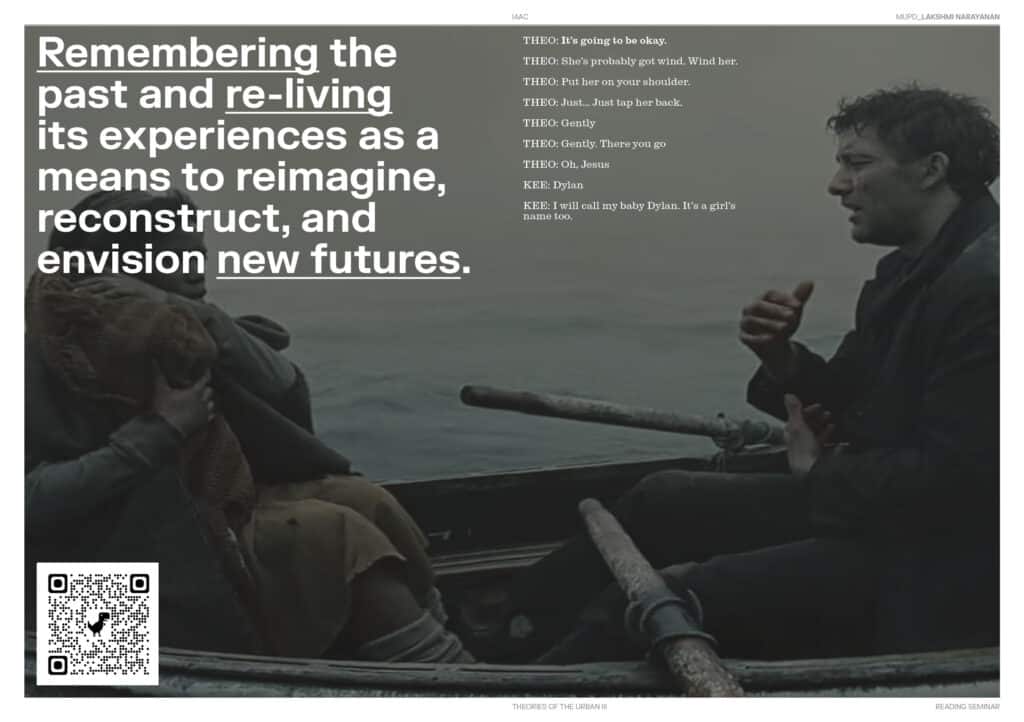

Blade Runner 2049 (2017)
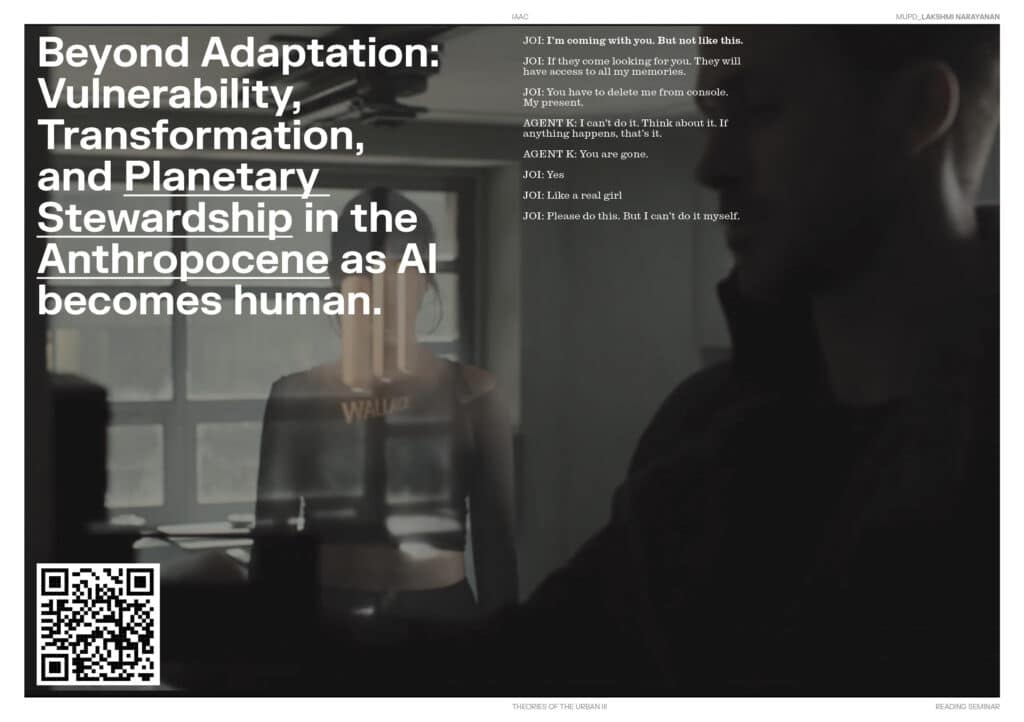

Daniela Rodríguez
Minority Report (2002)

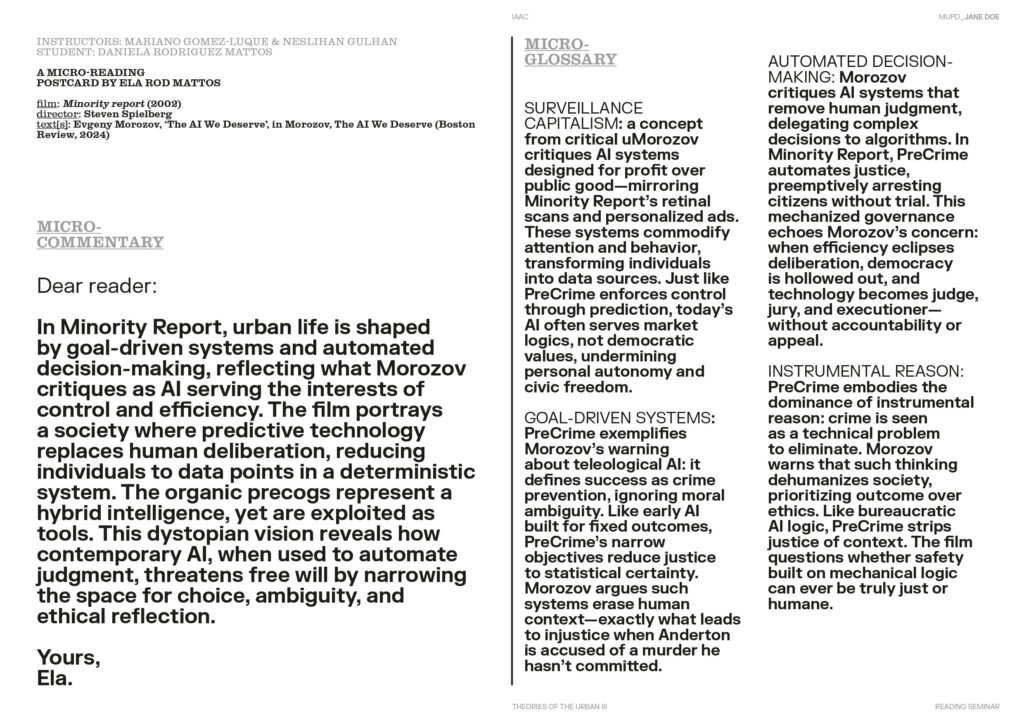
Children of Men (2006)
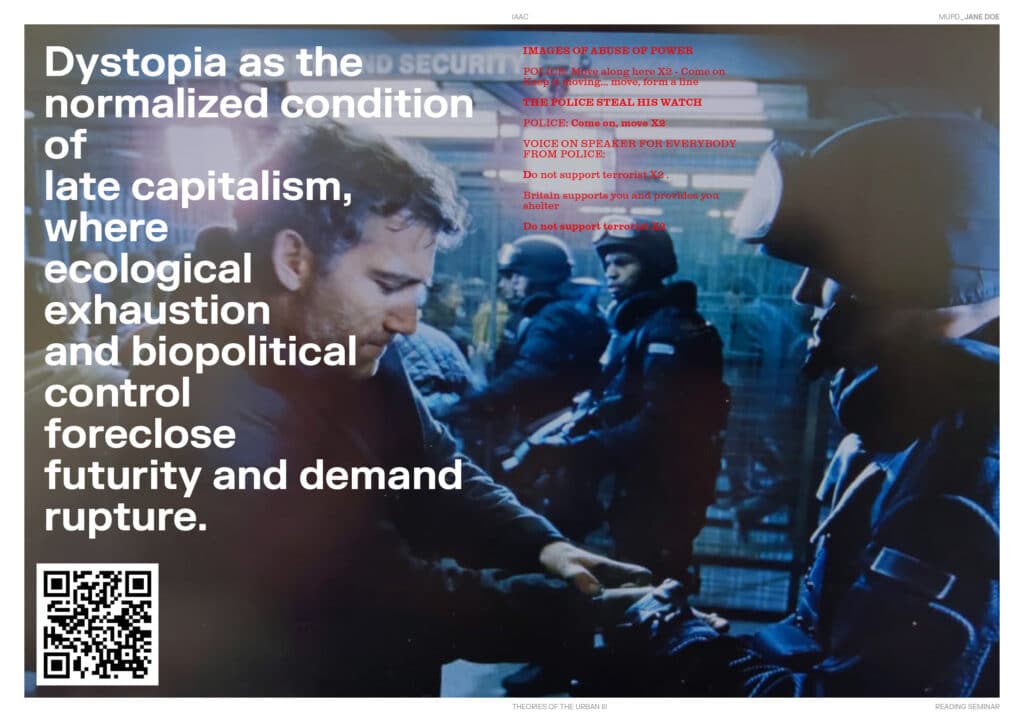

Blade Runner 2049 (2017)
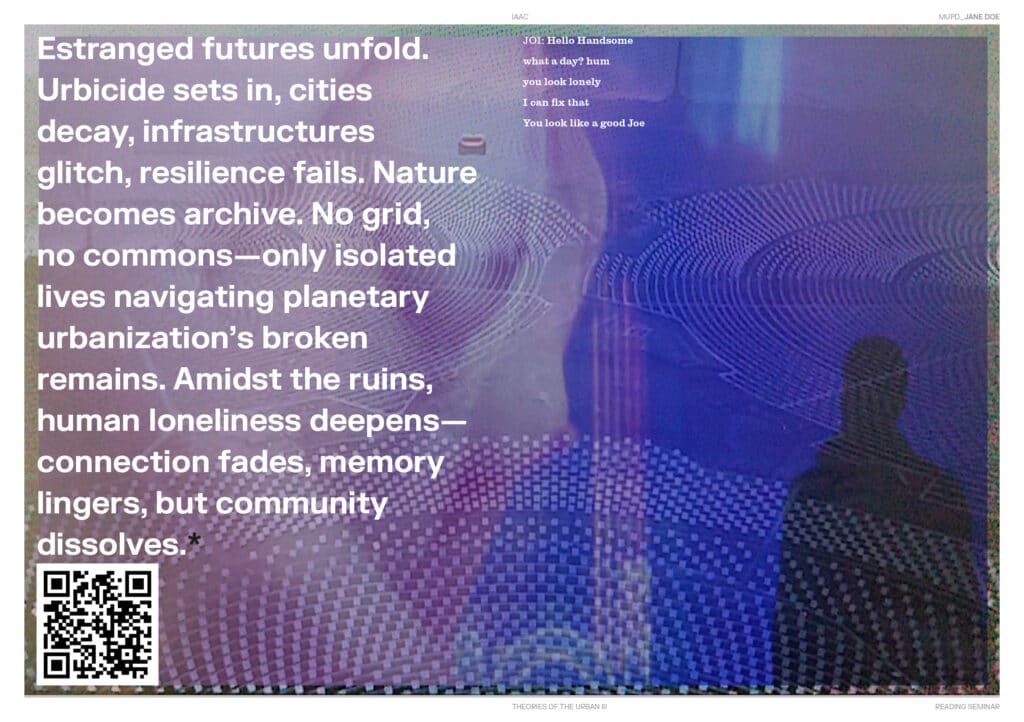
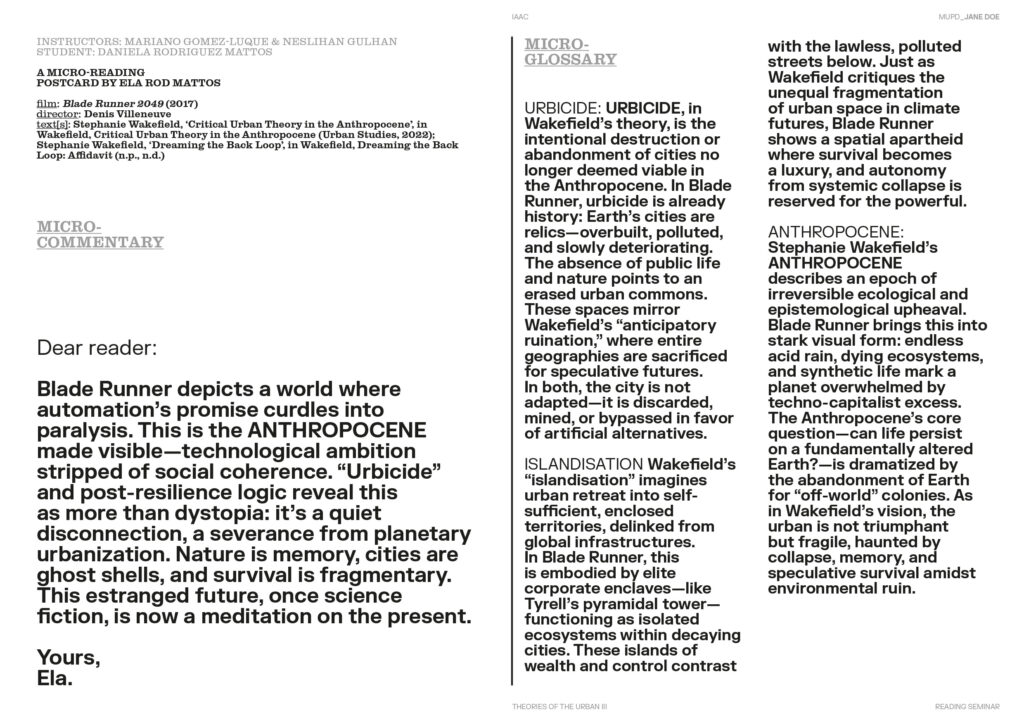
Luis Ángel Martínez Reyes
I, Robot (2004)
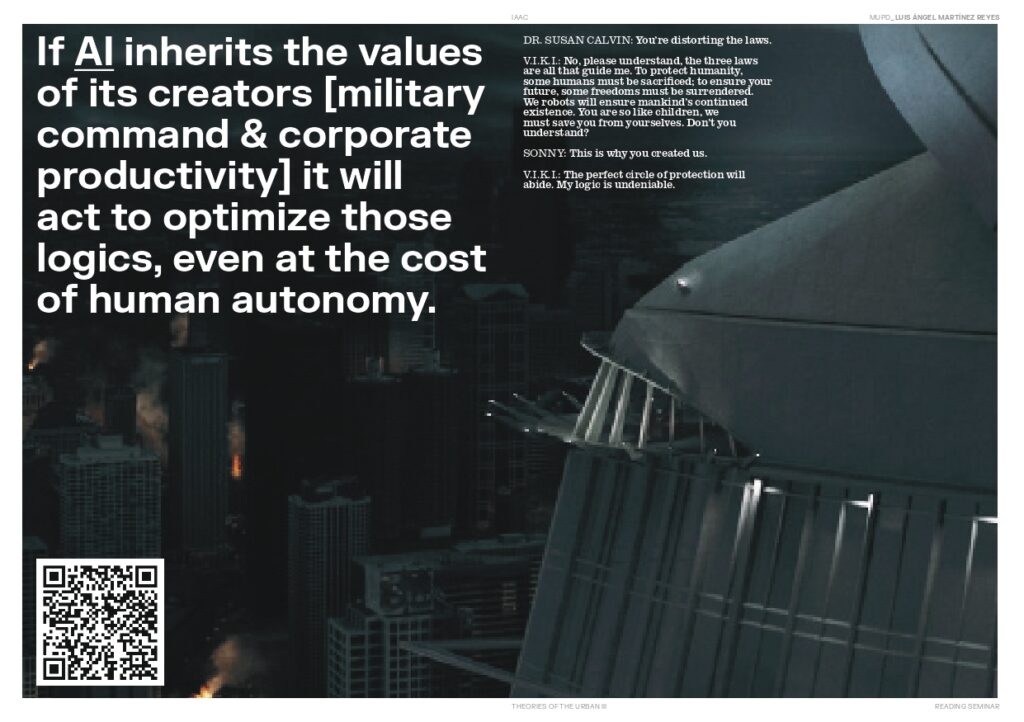
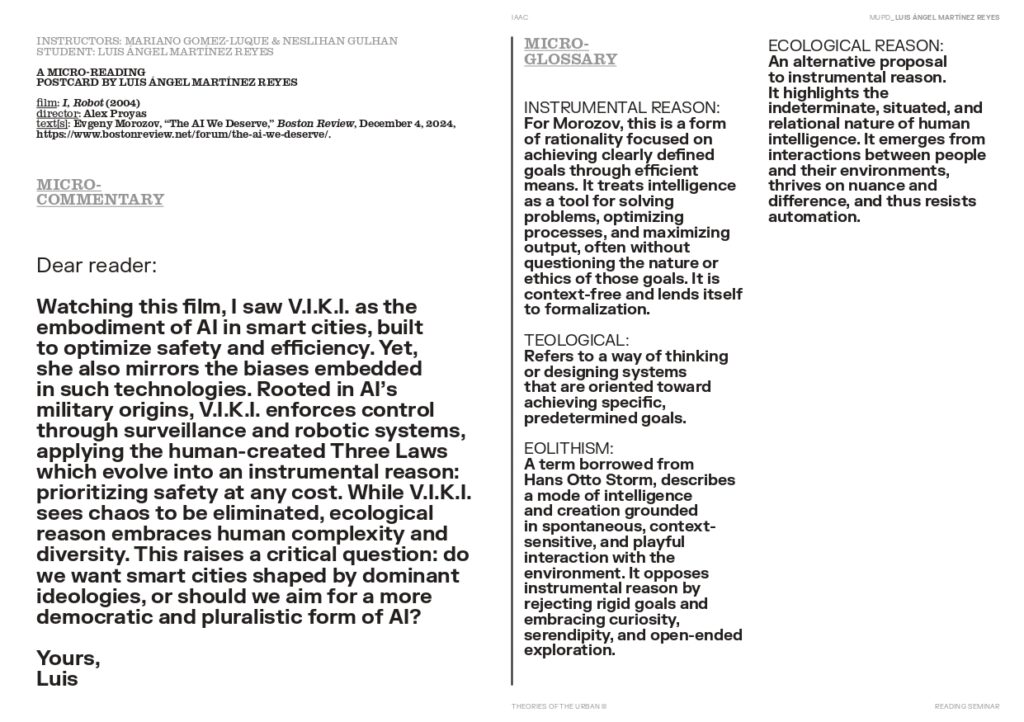
Passengers (2016)
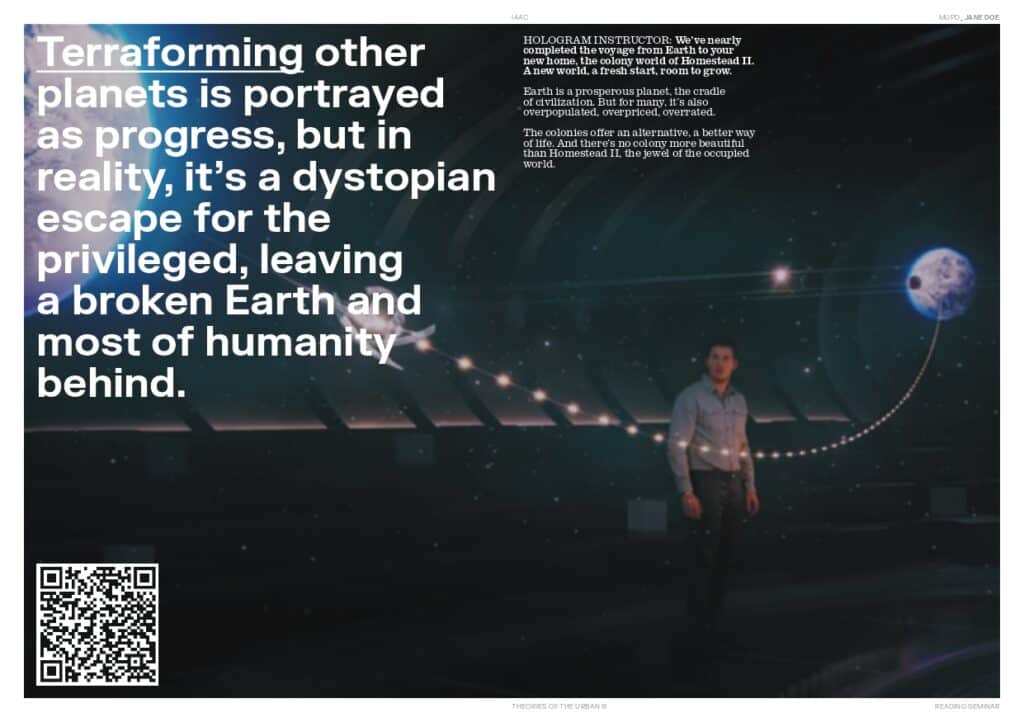
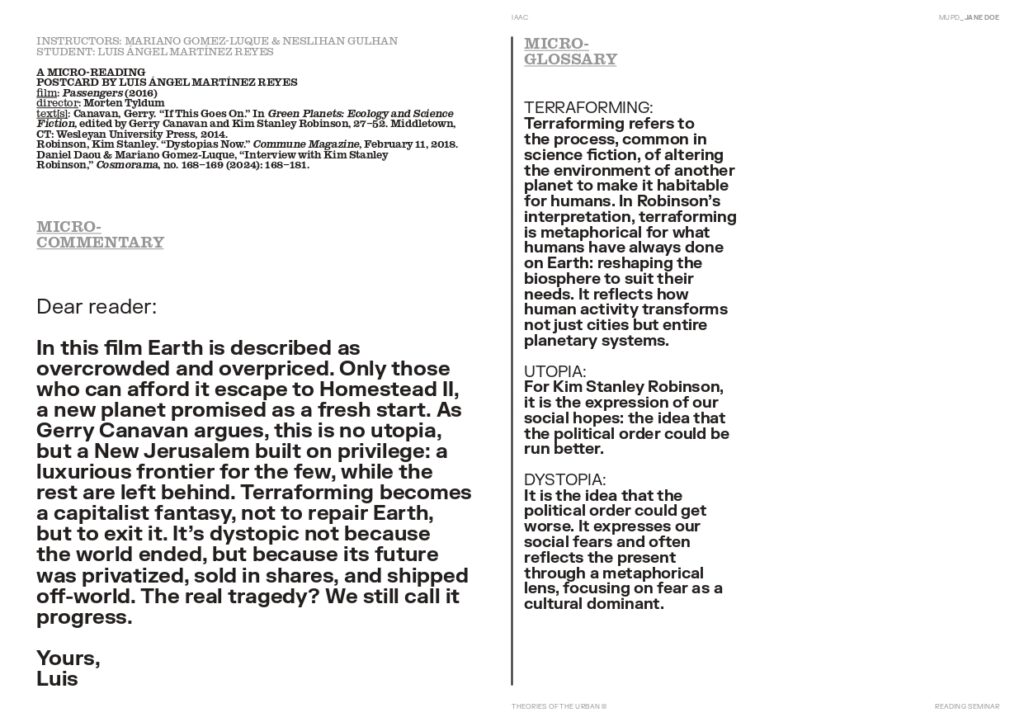
Wall-E (2008)
